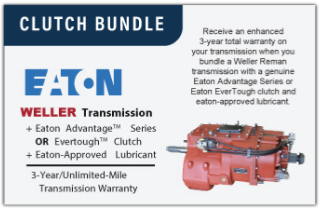18 Wheeler Transmissions & Differentials

"Transmissions and differentials have come a long way from the days of old, but maintenance practices never die."
Duke Wichers | Technical Service Manager
20 Year Experienced Master Tech
Transmissions and differentials have come a long way from the days of old, but maintenance practices never die. Eaton has a new fluid spec, PS-386. PS-386 is a synthetic transmission fluid designed for fuel efficiency, extended drain intervals, and severe service in heavy-duty commercial vehicle transmissions, which require a non-EP transmission lubricant. It is specially formulated to protect higher torque transmissions coupled with increased horsepower engines. Its approval is for use in Eaton transmissions such as Endurant, UltraShift PLUS, Fuller Advantage, FR, and RT Series transmissions. Drain intervals vary from 750,000 to as low as 180,000 depending on the application. Differential lubes remain 75W90 EP-5 gear lube. Meritor's spec is 076-N and 076-E while Dana is SHAES-256 Rev C. Line-haul applications still run 500,000 miles while Vocational applications run 120,000 miles between service events. During maintenance events, inspect for leaks. Even small leaks can have catastrophic consequences due to low lube levels. Also, inspect the vent; road dirt can block the vent causing leaks. When checking gear oil levels the oil should be at the bottom of the plug when the truck is level.
Allison automatic transmissions use TransSynd oil meeting Allison's TES-295 spec. Gen 4 and 5 transmissions use proprietary diagnostics and will turn the maintenance light on when it calculates the transmission is ready for service. Oil level checks can be done cold or hot, engine running in neutral. TransSynd has a red color but turns goldish red during normal service. Ensure the dipstick locks secure during checks, if not water can enter the transmission. Automatic transmissions also fail due to low lube levels, inspect for leaks. The last tip is do not use air or electric tools during filter services. Both the 3000 and 4000 series transmissions put torque specs at 38 to 45 pound-feet. The drain plug torques at 27 pound-feet. If you strip a bolt, the entire pan and valve body must be removed to repair.
For series 3000 and 4000 with WTEC II or later controls, the fluid level can be checked from the cab. It's the most accurate method, and the one preferred by Allison.
The steps are as follows:
- Park the vehicle on a level surface, shift to N (neutral), and apply the parking brake.
- Simultaneously press the "up and down arrows.
- The fluid-level check might be delayed until the following conditions are met: The fluid temperature is above 140 degrees and below 220 degrees Fahrenheit, the transmission is in neutral; the engine is at idle, the vehicle has been stationary for approximately two minutes to allow the fluid to settle
With a fourth-generation transmission control pad, results are displayed as follows:
- If the fluid check is delayed, the window will display a hyphen (-) followed by a numerical count down, starting at 8, indicating the time remaining in the two-minute settling period.
- If the fluid level is correct, o L" will be displayed, which stands for oil (fluid) level, followed by "o K." . If the fluid level is low, "o L" will be displayed, followed by "Lo," followed by the number of quarts it is low. For example, "o L Lo 02" indicates two quarts low.
- If the fluid level is high, "o L" will be displayed, followed by "HI" followed by the number of quarts it is high. An example is "o LH 01, which indicates one quart high.



